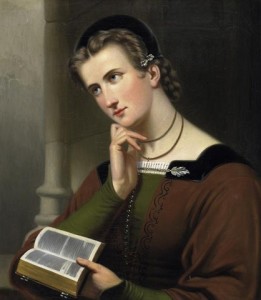Would Harry Potter have been such a success if he’d been called Nigel Clutterworth? I don’t think so.
I suspect most authors put quite a bit of time and effort into finding the right names for their characters – I certainly do. The Montmaray Journals contain more than sixty named characters, not counting all the real-life historical figures who appear in the story. Here’s how I named some of them:
Sophia comes from the Greek word for wisdom. She was called Elizabeth for a couple of days, but I changed it as soon as I realised that the novel was a getting-of-wisdom tale. Sophie is named after her twin aunts, Sophia and Margaret, who were born and died in 1894, and were going to play a ghostly role in A Brief History of Montmaray until I realised the supernatural elements in that book were getting out of hand. Elizabeth became Sophie’s third name. She’s also named after Jane, her mother (plain Jane), and Clementine, her grandmother (inspired by Winston Churchill’s wife).

Veronica is one of my favourite names for girls. It means ‘true icon’. Saint Veronica is the woman in the Bible who offered her veil to Jesus on his way to Calvary; the cloth is supposed to have been stained with his blood and sweat in the exact image of his face. I thought Veronica’s Catholic mother might have chosen that name, and I liked the irony of the family’s most vehement atheist being named after a saint. I also liked the idea of a name full of ‘truth’ (from Latin verus, ‘true’), because Veronica seems so determined to fill her life with facts.
Toby was called Thomas until a couple of days before the first Montmaray book went off to the typesetters. By that stage, my editor had shown the manuscript to a variety of people, nearly all of whom mentioned the novel I Capture the Castle in their feedback. While I could see the similarities between the two books (1930s, teenage girl, diary, castle), I thought the differences (island, royalty, Holy Grail, Nazis) were considerable. However, we both felt we should eliminate any minor similarities where we could, and I remembered that the narrator’s brother in I Capture the Castle was called Thomas. My editor suggested several alternative names, including Tristan, Alexander, Oberon, Benjamin and Adrian, but I decided on Tobias, shortened to Toby by most of the other characters. Now I can’t imagine Toby being called anything else.
Henry was initially Charlotte, shortened to Charlie. However, I ended up giving the name Charlotte to their overbearing aunt. Henry’s full name is Henrietta Charlotte.
Simon is a name I associate with sinister, dark-haired men. I have no idea why, and I offer apologies to any good-natured, blond Simons who are reading this. There is actually a Simon in I Capture the Castle, but he’s nothing like my Simon, so I didn’t bother changing his name.
Rebecca is also a name with sinister connotations, thanks to the Daphne du Maurier novel. It’s also another Biblical name, which is appropriate for the most religious character in the Montmaray series.
Julia was originally called Helena, which seemed a good name for a society beauty. However, Helena was too similar to Henry, so I changed it to Julia. Then I accidentally used the name Helena for a character who appears at the very end of The FitzOsbornes in Exile. Helena is such a minor character that she doesn’t even have any dialogue, so hopefully, the similarities to Henry’s name won’t matter to most readers.
Daniel needed a name that would suit the English grandson of Jewish immigrants from Vienna. As I was doing my usual searching-for-inspiration routine (looking at the author names on my bookshelves, flicking through the phone directory, staring at the contents of my kitchen cupboards), I came across a magazine full of photos of celebrities, including British actors Daniel Radcliffe and Orlando Bloom. Hence, Daniel Bloom. My Daniel’s family name was originally Rosenblum, but his grandparents changed it to Bloom to seem more English – so I was interested to read the recently published Mr Rosenblum’s List, by Natasha Solomons, in which the eponymous character changes his surname to ‘Rose’ for exactly the same reason.
The Colonel’s first name is an enigma even to me, as is fitting for an International Man of Mystery. I think he was called Peter at one stage, but some of my notes refer to him as Andrew. Who knows? It’s lucky that everyone, even his own brother, just calls him The Colonel.
As for the family name of the FitzOsbornes, I needed something grand and Norman, so I used William FitzOsbern as inspiration. He was one of the viceroys of William the Conqueror, who arrived in England in 1066. According to The National Trust Book of British Castles (an excellent read, with some wonderful photos), FitzOsbern built at least half a dozen castles in England in the five years after the Norman conquest. Spelling in those days was not very consistent, so I’ve also seen his name written as fitzOsbern and FitzOsborn. I eventually decided on FitzOsborne, and I’m not entirely certain that was a good idea. People keep spelling it as ‘FitzOsbourne’, so I guess that must be the most common spelling these days. Oh, well. It’s too late to change now.

Hey, I am currently reading Ann Veronica by H.G. Wells and I couldn’t help noticing how similar the Veronica’s were! So, I really that Veronica is a perfect name for a women interested in the world around her and social equality, good naming choice!
Oh, I haven’t read Ann Veronica. It sounds very interesting – I will add it to my To Read list.